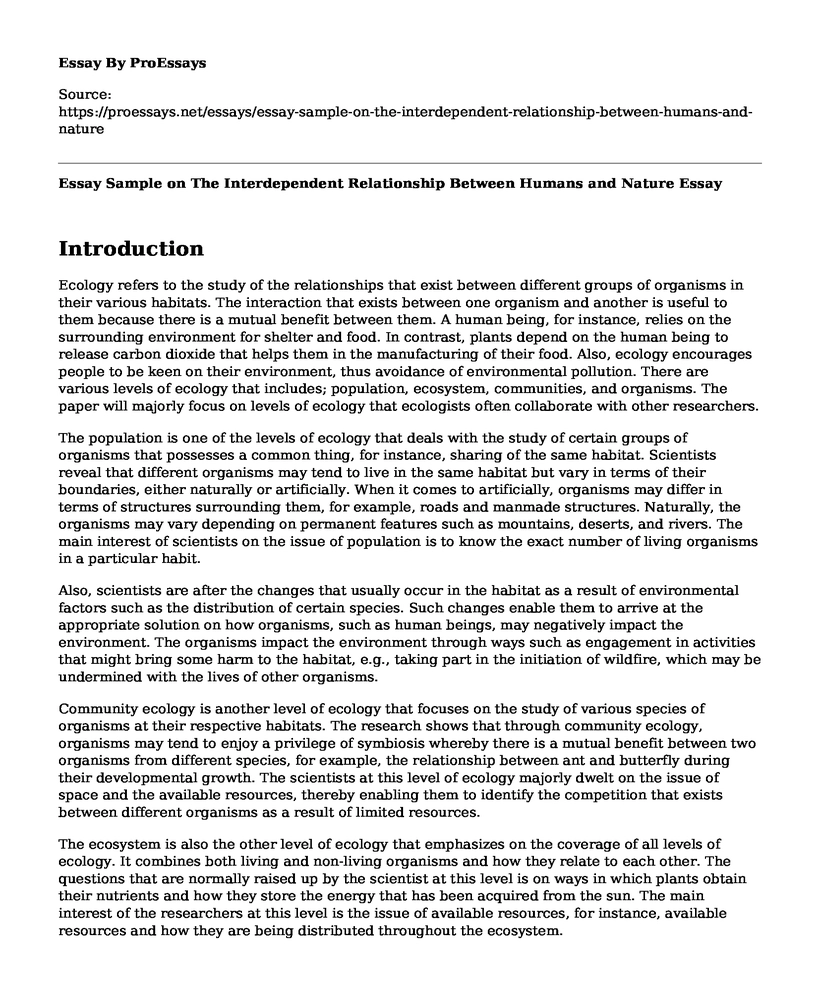Introduction
Ecology refers to the study of the relationships that exist between different groups of organisms in their various habitats. The interaction that exists between one organism and another is useful to them because there is a mutual benefit between them. A human being, for instance, relies on the surrounding environment for shelter and food. In contrast, plants depend on the human being to release carbon dioxide that helps them in the manufacturing of their food. Also, ecology encourages people to be keen on their environment, thus avoidance of environmental pollution. There are various levels of ecology that includes; population, ecosystem, communities, and organisms. The paper will majorly focus on levels of ecology that ecologists often collaborate with other researchers.
The population is one of the levels of ecology that deals with the study of certain groups of organisms that possesses a common thing, for instance, sharing of the same habitat. Scientists reveal that different organisms may tend to live in the same habitat but vary in terms of their boundaries, either naturally or artificially. When it comes to artificially, organisms may differ in terms of structures surrounding them, for example, roads and manmade structures. Naturally, the organisms may vary depending on permanent features such as mountains, deserts, and rivers. The main interest of scientists on the issue of population is to know the exact number of living organisms in a particular habit.
Also, scientists are after the changes that usually occur in the habitat as a result of environmental factors such as the distribution of certain species. Such changes enable them to arrive at the appropriate solution on how organisms, such as human beings, may negatively impact the environment. The organisms impact the environment through ways such as engagement in activities that might bring some harm to the habitat, e.g., taking part in the initiation of wildfire, which may be undermined with the lives of other organisms.
Community ecology is another level of ecology that focuses on the study of various species of organisms at their respective habitats. The research shows that through community ecology, organisms may tend to enjoy a privilege of symbiosis whereby there is a mutual benefit between two organisms from different species, for example, the relationship between ant and butterfly during their developmental growth. The scientists at this level of ecology majorly dwelt on the issue of space and the available resources, thereby enabling them to identify the competition that exists between different organisms as a result of limited resources.
The ecosystem is also the other level of ecology that emphasizes on the coverage of all levels of ecology. It combines both living and non-living organisms and how they relate to each other. The questions that are normally raised up by the scientist at this level is on ways in which plants obtain their nutrients and how they store the energy that has been acquired from the sun. The main interest of the researchers at this level is the issue of available resources, for instance, available resources and how they are being distributed throughout the ecosystem.
Organisms' ecology is also among the levels of ecology that enables the researchers to focus on how an organism adapts to the different ecological niche. The interest of the researchers at this level is to know how various species of organisms adapt to different ecological niche depending on behaviors, morphology, and psychology. In terms of behavior, a researcher may ask questions such as how an organism behaves when they are undergoing their various stages of development. (Jandt et al., 2014).
The level of ecology that is considered to be more difficult during collaboration is population ecology. This is because it is difficult to obtain the exact number of organisms at given habits due to the rampant distribution of organisms and the assumptions that are normally made during the process of population estimation that may result in leaving aside other groups of organisms uncounted.
Reference
Jandt, J. M., Bengston, S., PinterWollman, N., Pruitt, J. N., Raine, N. E., Dornhaus, A., & Sih, A. (2014). Behavioral syndromes and social insects: personality at multiple levels. Biological Reviews, 89(1), 48-67.
Cite this page
Essay Sample on The Interdependent Relationship Between Humans and Nature. (2023, May 22). Retrieved from https://proessays.net/essays/essay-sample-on-the-interdependent-relationship-between-humans-and-nature
If you are the original author of this essay and no longer wish to have it published on the ProEssays website, please click below to request its removal:
- Essay Example on Interconnectedness
- How to Prepare for Hurricane Season Essay
- Animal Cognition Is Evolving With the Changes in the Environment Essay
- Essay Sample on Global Warming: Actions Taken and Effectiveness
- Essay Sample on Solving Climate Crisis: Can We Reduce Carbon Levels?
- Essay Example on Primate Evolution: Changes in Locomotion & Body Structure
- Index Properties of Soil - Essay Sample







